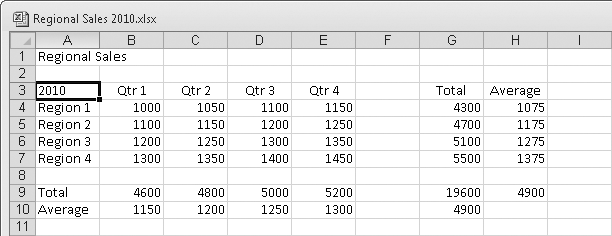A region is a rectangular range of cell entries, or a block of “filled cells.” In Figure 6-1, the range A3:E7 is a region, as are the ranges G3:H7, A9:E10, and G9:H10. (Strictly speaking, cell A1 is a one-cell region, too.) For example, cell H10 is within a region, even though it’s empty.
The active area of the worksheet is the selection rectangle that encompasses all regions—that is, all the filled cells in the active worksheet—which in Figure 6-1 is A1:H10.
The techniques you can use to navigate regions are helpful if you typically work with large tables of data. Getting to the bottom row of a 500-row table is easier when you don’t have to use the scroll bars.
Figure 6-1. There are four regions—blocks of “filled” cells—on this worksheet that are separate regions.
Note
The small square in the lower-right corner of the active cell is the fill handle. If the fill handle isn’t visible on your screen, it means it isn’t turned on. To turn it on, click the File tab, click Options, click the Advanced category, and select the Enable Fill Handle And Cell Drag-And-Drop check box.
Here is a great way to move around fast without taking your hands off the keyboard. To jump from edge to edge within and between regions, hold down the Ctrl key, and then press any of the arrow keys. For example, in Figure 6-1, cell A3 is the active cell; press Ctrl+Right Arrow to activate cell E3. Press Ctrl+Right Arrow again and the active cell jumps to G3, then H3, and finally XFD3—the last available cell in row 3. Just keep pressing Ctrl+Left Arrow to return.
The dark border around the selected cell or cells is called a selection rectangle. When you move the plus-sign pointer over the selection rectangle, the pointer becomes a four-headed arrow. When the arrow pointer is visible, double-click to jump from edge to edge among regions; the mouse equivalent of the Ctrl+Arrow keyboard method described earlier. For example, double-clicking the bottom of the single-cell selection rectangle in Figure 6-1 selects cell A7.
The left side of the status bar displays the mode indicators in Table 6-1 when the corresponding keyboard mode is active.
Table 6-1. Keyboard Modes
Table 6-2 shows how you can use the Home and End keys alone and in conjunction with other keys to make selections and to move around a worksheet.
Table 6-2. Keyboard Shortcuts for Navigation
|
Press |
To |
|---|---|
|
Move to the first cell in the current row. | |
|
Ctrl+Home |
Move to cell A1. |
|
Move to the last cell in the last column in the active area. For example, in Figure 6-1, pressing Ctrl+End selects cell H10. | |
|
End |
Start End mode, and then press an arrow key to move around by cell region. |
|
Move to the first cell within the current window. | |
|
Move to the last cell within the current window. |

